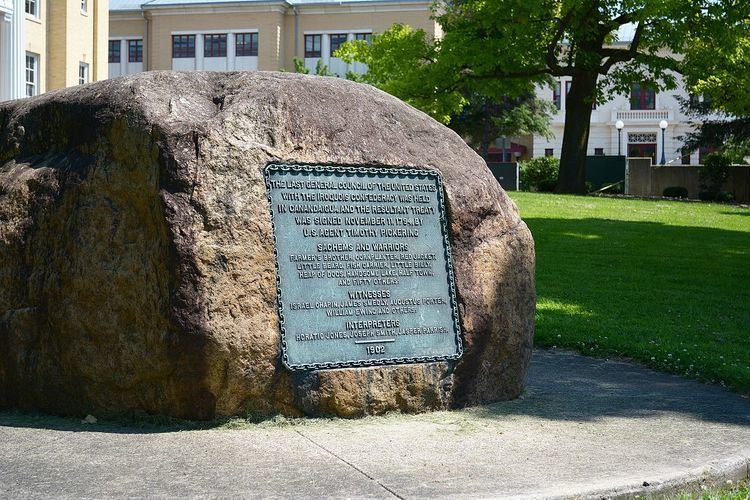 | ||
The Treaty of Canandaigua (or Konondaigua, as spelled in the treaty itself) is a treaty signed after the American Revolutionary War between the Grand Council of the Six Nations and President George Washington representing the United States of America.
Contents
It was signed at Canandaigua, New York on November 11, 1794, by fifty sachems and war chiefs representing the Grand Council of the Six Nations of the Iroquois (Haudenosaunee) Confederacy (including the Cayuga, Mohawk, Oneida, Onondaga, Seneca and Tuscarora tribes), and by Timothy Pickering, official agent of President George Washington.
Background of the Treaty
In the late 1780s and early 1790s the state of New York had sought the land of the Six Nations and began to pursue deceptive and illegal land transactions with the Native Americans. Both the making of treaties and the outright purchases of land by the individual states were illegal under Article 9 of the Articles of Confederation and also under the Commerce Clause of the United States Constitution. Despite this, New York secured 26 leases, many for 999 years, taking almost all the native territory. Becoming worried that these maneuvers might push the Six Nations to join the pan-Indian military alliance to defend the Ohio Valley, the United States Federal government sent a delegation to Canandaigua in the Seneca Territory.
Contents of the Treaty
The treaty established peace and friendship between the United States of America and the Six Nations, and affirmed Haudenosaunee land rights in the state of New York, and the boundaries established by the Phelps and Gorham Purchase of 1788.
The land of the Seneka nation is bounded as follows: Beginning on Lake Ontario, at the north-west corner of the land they sold to Oliver Phelps, the line runs westerly along the lake, as far as O-yong-wong-yeh Creek [Four Mile Creek], at Johnson's Landing-place, about four miles eastward d from the fort of Niagara; then southerly up that creek to its main fork, then straight to the main fork of Stedman's creek, which empties into the river Niagara, above fort Schlosser, and then onward, from that fork, continuing the same straight course, to that river; (this line, from the mouth of O-yong-wong-yeh Creek to the river Niagara, above fort Schlosser, being the eastern boundary of a strip of land, extending from the same line to Niagara river, which the Seneka nation ceded to the King of Great-Britain, at a treaty held about thirty years ago, with Sir William Johnson;) then the line runs along the river Niagara to Lake Erie; then along Lake Erie to the north-east corner of a triangular piece of land which the United States conveyed to the state of Pennsylvania, as by the President's patent, dated the third day of March, 1792; then due south to the northern boundary of that state; then due east to the south-west corner of the land sold by the Seneka nation to Oliver Phelps; and then north and northerly, along Phelps's line, to the place of beginning on Lake Ontario. Now, the United States acknowledge all the land within the aforementioned boundaries, to be the property of the Seneka nation; and the United States will never claim the same, nor disturb the Seneka nation, nor any of the Six Nations, or of their Indian friends residing thereon and united with them, in the free use and enjoyment thereof: but it shall remain theirs, until they choose to sell tie same to the people of the United States, who have the right to purchase.
It was the second diplomatic agreement entered into by the United States of America under its current Constitution (the first was the Treaty of New York, made with the Creek Indians in 1790).
The treaty, also known as the Pickering Treaty and the Calico Treaty, is still actively recognized by the United States and the nations of the Haudenosaunee confederacy. However, in 1960, 10,000 acres (4,000 ha) of the Allegheny Reservation were legally condemned by eminent domain during construction of Kinzua Dam, causing relocation of 600 Seneca.
The Six Nations in New York were still receiving calico cloth as payment under the treaty, while the Oneida Nation of Wisconsin were still receiving an annuity check of $1,800, as late as 1941, almost 150 years after the treaty took effect.
Signatories
The treaty was signed by fifty Sachems and War Chiefs.
Notable signatories include:
TIMOTHY PICKERING
Witnesses
Israel Chapin, Wm. Shepard Jun'r, James Smedley, John Wickham, Augustus Porter, James H. Garnsey, Wm. Ewing, Israel Chapin, Jun'r
Interpreters
Horatio Jones, Joseph Smith, Jasper Parrish, Henry Abeele,
